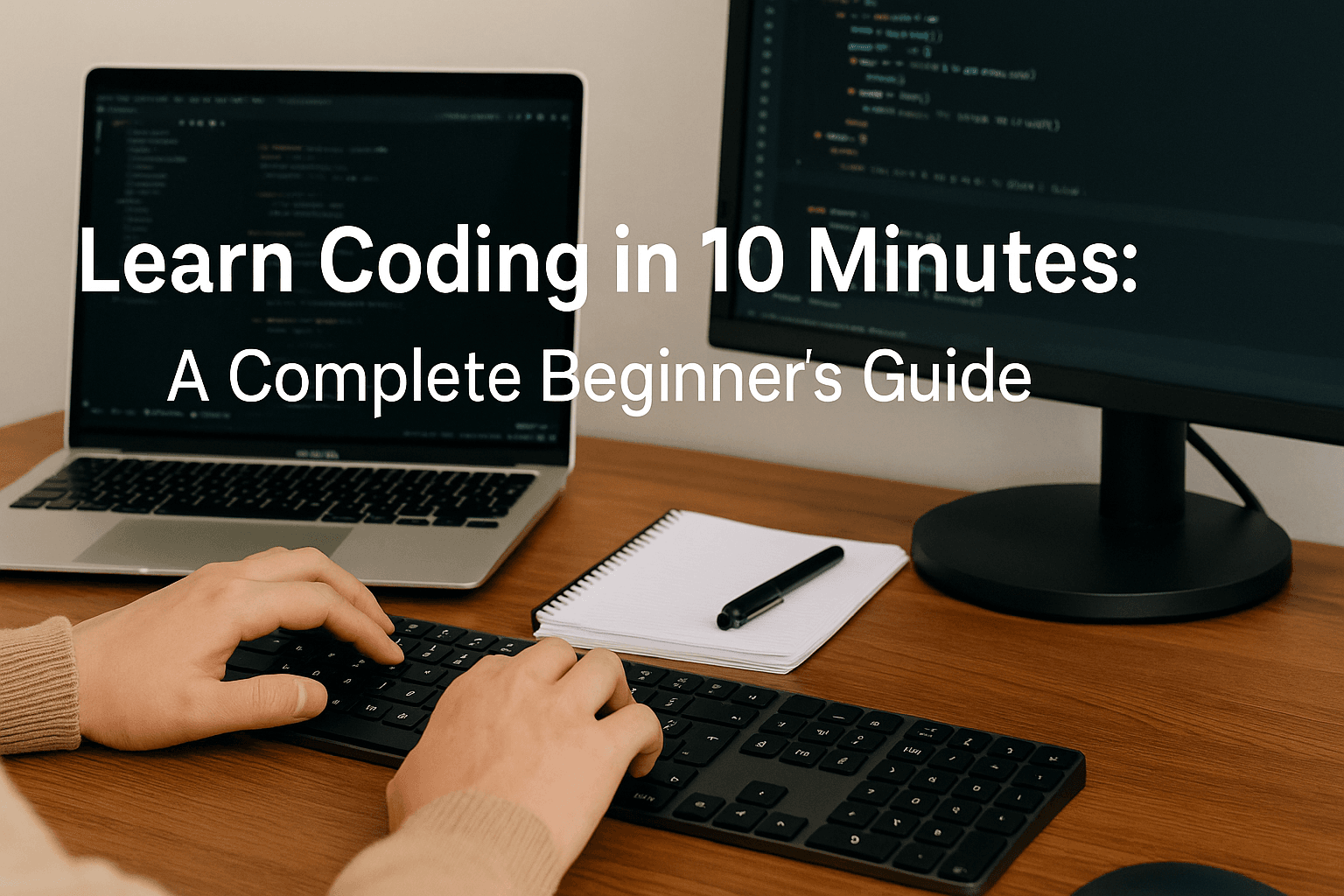Introduction: Why Learning to Code Matters Today
In today’s digital world, coding is no longer reserved for computer scientists or professional developers. It has become a 21st-century literacy skill—a way of solving problems, expressing ideas, and building tools that shape our daily lives. Whether you want to automate a boring task, create a website, analyze data, or simply understand how apps and games are made, learning to code is the key that unlocks these opportunities.
The good news? Learning coding doesn’t have to be overwhelming. You don’t need years of study or expensive courses to get started. With the right approach, you can understand the basics, write your first lines of code, and even complete a mini-project in just minutes.
This guide is designed for complete beginners. In less than ten minutes, you’ll set up your coding environment, learn the essential building blocks of programming with Python, and create a working quiz game project. By the end, you won’t just know about coding—you’ll have actually written and run a real program.
Part 1: Why Start With Python?
When people first decide to learn coding, the biggest question is: Which programming language should I choose?
Here’s why Python is widely recommended for beginners:
Simple, readable syntax: Python code looks almost like English. This makes it easier for newcomers to grasp concepts without getting lost in complicated symbols.
One line, and you’ve just written your first program.
Versatility: Python is everywhere—used in web development, data science, machine learning, AI, automation, game development, and more. Whatever direction you take later, Python skills will be valuable.
Huge community and resources: Because Python is so popular, you’ll find tutorials, courses, documentation, and forums everywhere. That means when you get stuck, answers are only a Google search away.
Career opportunities: From entry-level developers to data analysts, Python is in demand across industries.
👉 Simply put, Python is the best return on investment for your time as a beginner.
Part 2: Setting Up Your Coding Environment
Before writing code, you’ll need a place to do it. Here’s a quick, step-by-step guide to getting started.
Step 1: Install Python
Go to python.org.
Download the latest version (Python 3.x).
During installation, check the box that says “Add Python to PATH.”
After installation, confirm it’s working:
On Windows, open Command Prompt → type
python --versionOn macOS/Linux → type
python3 --version
Step 2: Install VS Code (Your Editor)
Download from code.visualstudio.com.
Install, then open VS Code.
Add the Python extension (Microsoft’s official plugin). This enables auto-complete, syntax highlighting, and debugging—everything a beginner needs.
Now you have everything ready: Python to run your code, and VS Code to write and manage it.
Part 3: Learn the Basic Building Blocks of Coding
To learn coding, you must first understand the building blocks that all programming languages share. Let’s cover the essentials:
1. Variables
Variables are like containers that store information.
2. Data Types
Every value in Python has a type:
Integer (int): whole numbers, e.g.
42Float: decimals, e.g.
3.14String (str): text, e.g.
"Hello"Boolean (bool):
TrueorFalseList: ordered collection, e.g.
[1, 2, 3]Dictionary: key-value pairs, e.g.
{"name": "Alice", "age": 20}
3. Functions
Functions group code so you can reuse it.
4. Conditionals (if/else)
Programs often need to make decisions.
5. Loops
Loops repeat tasks without writing the same code over and over.
👉 With these five concepts, you can already create useful programs.
Part 4: Build Your First Python Project — A Quiz Game
Nothing cements learning like building something. Let’s create a quiz game that asks questions and checks answers.
Step 1: Create the file
Open VS Code → create a new file named quiz_game.py.
Step 2: Add questions & score tracking
Step 3: Add quiz logic
Step 4: Show results
👉 Run the file in your terminal:
Windows:
python quiz_game.pyMac/Linux:
python3 quiz_game.py
Congratulations—you just wrote and executed your first complete program.
Part 5: Debugging & Common Errors
Don’t panic if you see errors. Everyone does—errors are part of coding.
SyntaxError: usually missing a colon, parenthesis, or wrong indentation.
NameError: using a variable before defining it.
TypeError: mixing types (e.g. adding a number to text).
IndexError: trying to access something outside a list’s range.
👉 Copy error messages into Google/Stack Overflow. You’ll often find quick fixes.
Part 6: Expand Your Project & Keep Learning
Once your quiz works, try adding features:
High scores: Save scores to a file.
Timer: Add a countdown per question.
Levels: Easy, medium, hard question sets.
GUI version: Use Tkinter for a simple interface.
Beyond this project, here’s a roadmap:
Build small tools (calculator, to-do list).
Explore libraries (Pandas for data, Flask for web).
Practice challenges on LeetCode or HackerRank.
Join coding communities (Stack Overflow, Reddit r/learnprogramming).
Consistency beats intensity. Even 20 minutes a day compounds into real skills over time.
Conclusion: Your First Step Into Coding
In just minutes, you:
Installed Python & VS Code
Learned coding basics (variables, functions, loops)
Built and ran a working project
Discovered how to debug and grow
You’re not just “learning about coding” anymore—you’re already coding.
The next step is simple: keep practicing, build small projects, and stay curious. Every great developer started with a single line of code—today, you wrote yours.
👉 Start now. Open VS Code, create a file, and keep building.
